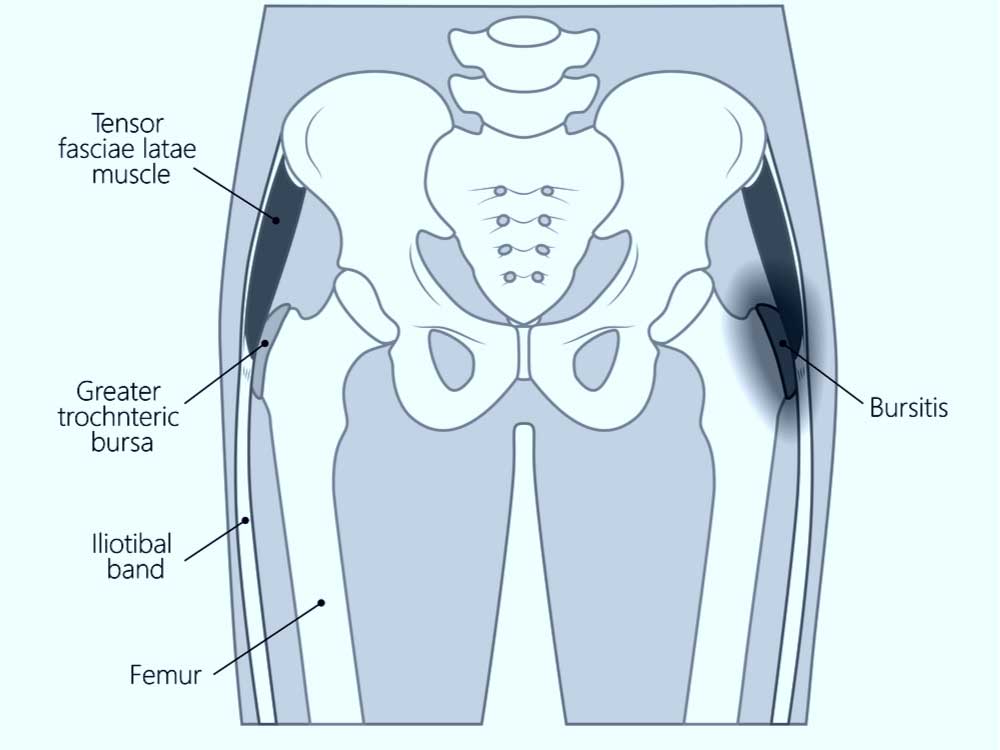Hip Bursitis Specialist

Are you experiencing pain with hip motion? If so, you may be experiencing trochanteric bursitis (hip bursitis). Trochanteric bursitis, an inflammation of the bursa, is commonly seen in older individuals and younger athletes who are active in exercises such as running, walking or biking. Hip bursitis specialist, Doctor Benedict Nwachukwu provides diagnosis as well as surgical and nonsurgical treatment options for patients in Manhattan, New York City, NY who are experiencing hip pain. Contact Dr. Nwachukwu’s team today!
What is Trochanteric Bursitis?
The greater trochanter is a bony prominence on the outside of the hip located where one would find a side-pant pocket. This part of the femur (thigh bone) can be felt with movement of the hip and can be palpated on the outside of the hip. During movement, the greater trochanter slides past the iliotibial (IT) band and moves without friction, thanks to the trochanteric bursa. The thin, fluid-filled sacs of tissue in the trochanteric bursa lubricate the area, allowing the joint to move smoothly and painlessly.
If, however, the bursa becomes inflamed, the result can be pain with hip motion called trochanteric bursitis. Trochanteric bursitis is commonly seen in older individuals and younger athletes who are active in exercises such as running, walking or biking. Dr. Benedict Nwachukwu, orthopedic hip specialist, can diagnose and treat this common hip condition in patients living in Manhattan, New York City and the surrounding New York boroughs.

Why does the bursa in the hip become inflamed?
There are about 160 bursae around the human body. The bursae’s job is to provide a cushion between the bones and soft tissue to prevent the bones from rubbing against tendons and muscles. When one or more bursae become inflamed, pain is the unpleasant side effect. In fact, bursitis of the hip is the most common cause of hip pain. Some factors that make individuals in New York more susceptible to developing hip bursitis are:
- Hip Injury – Traumatic bursitis caused by a fall or a hit to the hip which can cause the bursa to fill with blood and the lining to become inflamed.
- Repetitive pressure on the hip – Caused by frequent mini-traumas, or overuse and often seen in individuals who run, walk, bike or stand for long periods of time.
- Age and gender – Most often, individuals age 40 – 60+ are more likely to develop trochanteric bursitis and women are more likely to report this specific type of pain in the side of the hip than men.
- Gout – A painful condition where a build-up of urate crystals form in the synovial joints, causing pain.
What are the symptoms of hip bursitis?
Symptoms most often reported by patients experiencing trochanteric hip bursitis are:
- Pain in the hip directly over the bump that forms the greater trochanter.
- Pain that can radiate down the hip to the outside of the thigh
- Limping
- Swelling in the affected leg
- Dull ache outside the joint
- Pain that worsens at night, preventing sleep
- Stiffness and trouble walking after sitting for too long
How is trochanteric bursitis diagnosed?
Dr. Nwachukwu will conduct a thorough physical examination and will get a specific history of activities to get a better idea of how and when the pain started. Pertinent physical exam tests will be conducted to look for tenderness, tightness in the iliotibial band and other pathology of the hip. An X-ray will be ordered to determine if any other condition associated with the joint itself is present. In some cases, an MRI may be needed. Dr. Nwachukwu may be able to determine if you have trochanteric bursitis by injecting a local anesthetic into the bursa. If the pain goes away, then the diagnosis is usually accurate.
How is trochanteric bursitis treated?
Non-Surgical Treatment:
The majority of patients who have trochanteric bursitis will not require surgery. Younger patients who are active in sports may need to reduce their activities and rest for a specific period of time. Physical therapy is usually recommended and involves stretching and strengthening movements. A cortisone injection or anti-inflammatory medication may also help moderate the pain and decrease the inflammation. The hip bursitis typically begins to resolve within 4-6 weeks of appropriate conservative treatment measures.
Surgical Treatment:
If conservative treatment measures fail to alleviate pain, surgery may be needed to treat bursitis in the hip. Dr. Nwachukwu will treat trochanteric bursitis using an arthroscopic surgical procedure involving a camera and small incisions to clean up and remove the excess bursa. At the time of surgery, the hip joint itself will be visualized in order to ensure that there are no other abnormalities in the hip joint that are contributing to this condition. Any abnormalities in the hip joint itself will be addressed arthroscopically.
What is the recovery time following trochanteric bursitis surgery?
For patients who do undergo surgery, it is very important to follow the protocol for post-operative recovery as set forth by Dr. Nwachukwu. He will provide a well-supervised physical therapy program following arthroscopic hip surgery so that a normal range of motion and mobility can be achieved.
For more information about trochanteric bursitis, or to be evaluated for your specific hip pain, please contact the office of Benedict Nwachukwu, MD, orthopedic hip specialist serving Manhattan, New York City and surrounding New York boroughs.